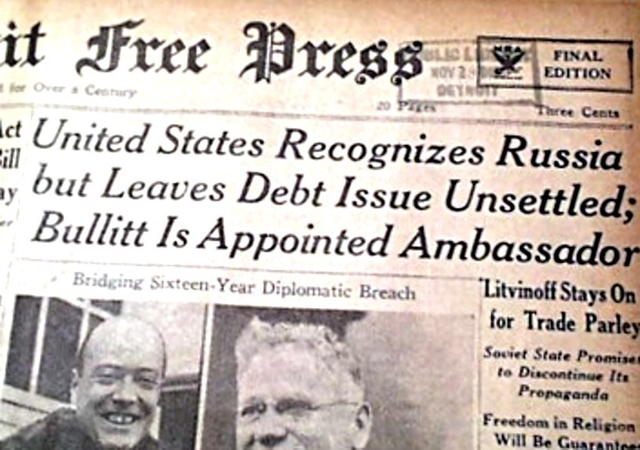
Tomorrow, Nov. 22, Ukraine will pause to remember its dead. Across the country – in cities under bombardment and villages near the front lines – Ukrainians will light candles for the millions who were deliberately starved to death between 1932 and 1934. The Holodomor, “death by hunger,” was not a famine but a genocide: Joseph Stalin’s systematic murder of at least four million Ukrainians through engineered starvation.
As they prepare to commemorate that betrayal, they face another.
JOIN US ON TELEGRAM
Follow our coverage of the war on the @Kyivpost_official.
Donald Trump is preparing to betray Ukraine again. As Russia’s barbaric invasion enters its third year, the American president speaks openly about forcing Kyiv to surrender territory and “ending the war” by rewarding Putin’s aggression. Trump dismisses war crimes as unfortunate necessities, praises Putin’s “genius,” and promises a deal that would allow the Kremlin’s dictator to get away with everything.
The message is clear: Ukraine’s suffering matters less than Trump’s desire for a quick diplomatic victory and the profit he can gain from it.
We have seen this before. Nearly a century ago, the world’s democracies made the same choice. Ukraine – at that time under Soviet Russian rule as a nominally “independent” republic within the USSR – paid the price then as well.
Everyone remembers Neville Chamberlain’s umbrella and his promise of “peace for our time.” We recall the shame of Munich 1938, when Western democracies sacrificed Czechoslovakia to Hitler’s ambitions. But the true beginning of appeasement – the original sin that taught totalitarian dictators they could murder with impunity – occurred five years earlier. That was when the world’s democracies turned their backs on millions of starving Ukrainians and, for that matter, Kazakhs in Central Asia who were being forcibly collectivized, while embracing their executioner.
Other Topics of Interest
Russian Guided Bomb Strike Kills 5 in Zaporizhzhia as Region Comes Under Heavy Fire
Authorities warn of further guided bomb strikes as emergency crews worked through the night and air raid alerts rang across the wider Zaporizhzhia region.
Between 1932 and 1934, Stalin engineered one of history’s most horrific crimes: the deliberate starvation of the Ukrainian people. At least four million are estimated to have died, along with more than a million Kazakhs in another part of the USSR.
This was not a natural disaster in Ukraine. Stalin systematically confiscated grain, sealed the borders to prevent escape, and sent armed brigades to seize the last kernels of wheat from starving families. Children with distended bellies wandered through empty villages. Parents watched their children die. Cannibalism emerged in the countryside.
By controlling information, manipulating foreign visitors, and leveraging ideological sympathies, Stalin’s regime obscured one of the most significant humanitarian catastrophes and crimes in human history. Foreign diplomats and journalists were carefully managed through controlled tours and shown Potemkin villages that concealed the horrific reality of systematic starvation.
Journalists such as Walter Duranty of The New York Times deliberately misreported the situation, winning a Pulitzer Prize for articles that denied the genocide while millions perished. Prominent intellectuals such as George Bernard Shaw, H.G. Wells, and Lion Feuchtwanger toured Soviet territories, praised Stalin’s regime, and dismissed reports of mass starvation.
French politician Edouard Herriot conducted a carefully managed tour of Ukraine, declaring to the world that no famine existed, despite overwhelming evidence of widespread death and suffering.
The United States, a beacon of democracy and human rights, chose to legitimize Stalin’s regime at the very moment it was committing mass murder.
However, despite this complicity, Western governments were aware. A few courageous Western journalists managed to get the truth out – Malcolm Muggeridge, Gareth Jones, and Rhea Clyman. Diplomatic cables documented the catastrophe. The evidence was there for anyone willing to see it.
Yet in November 1933, as the death toll rose into the millions, US President Franklin Roosevelt extended diplomatic recognition to the Soviet Union. The United States, a beacon of democracy and human rights, chose to legitimize Stalin’s regime at the very moment it was committing mass murder.
The decision was pragmatic, we were told. The USSR was a potential trading partner, a counterweight to Japanese expansion in Asia. Realpolitik demanded engagement.
The following September, the pattern repeated. The League of Nations – that noble experiment in collective security and international law – invited the Soviet Union to join its ranks. The same organization, founded to prevent atrocities and protect the weak, welcomed a regime that had just starved millions of its own citizens.
Stalin’s USSR gained legitimacy and respectability through international recognition, while Ukrainian villages remained graveyards and Kazakh nomads lay dead on the steppe. During the next years, purges decimated the Ukrainian cultural intelligentsia and Russification was stepped.
What message did this send?
When democracies embrace a totalitarian murderer and prioritize stability and strategic advantage over moral principle, they teach a simple lesson: Mass murder has no consequences.
Chamberlain’s betrayal of Czechoslovakia was not an aberration; it was a continuation.
Hitler was watching. Mussolini was too. They saw the international community wring its hands, issue concerned statements and then return to business as usual. They learned that democracies were weak, their proclaimed values negotiable, and their leaders would always choose comfort over courage.
This is the direct line from the Holodomor to Munich. Chamberlain’s betrayal of Czechoslovakia was not an aberration; it was a continuation. The West had already established the precedent: totalitarian regimes could commit atrocities, and democracies would respond with engagement rather than isolation, with recognition rather than condemnation. Europe and the US had already shown they would sacrifice principle for perceived pragmatism, abandoning the vulnerable for the sake of their own interests.
The cost of this moral failure cannot be measured solely in Ukrainian and Kazakh lives, though those millions of dead demand remembrance. The cost must also be assessed by what followed.
Would Hitler have been so bold if the democracies had isolated Stalin rather than embraced him? Would the path to World War II have been different if the West had drawn a line in 1933 and declared that regimes deliberately starving millions would be treated as pariahs, not partners?
Would the League of Nations, in its dying gasp in 1939, have expelled the USSR for invading Finland?
Donald Trump proposes to do in 2025 what Roosevelt did in 1933: legitimize a Russian dictator’s crimes against Ukraine in the name of pragmatic engagement.
Would Roosevelt and Churchill have ended up at Yalta, allowing one totalitarian, Stalin, to dominate half of Europe after another – his former Nazi ally turned enemy, Hitler – had been defeated by their “unholy alliance”?
We cannot know. But we do know this: appeasement began not with weakness toward Hitler, but with complicity toward Stalin.
And now, nearly a century later, we stand at the same crossroads.
Donald Trump proposes to do in 2025 what Roosevelt did in 1933: legitimize a Russian dictator’s crimes against Ukraine in the name of pragmatic engagement. Just as Western democracies shook hands with Stalin while Ukrainian children starved, Trump wants to shake hands with Putin while Ukrainian cities burn and kidnapped Ukrainian children are held captive in Russia.
The details differ, but the moral calculus remains the same. Sacrifice Ukraine. Reward the aggressor. Call it peace. Declare victory. Move on.
Have we learned nothing? Does history teach us nothing? Are we condemned to repeat the same moral failures, generation after generation, always choosing convenience over courage, always prioritizing our comfort over others’ survival?
When we prioritize short-term stability over long-term principle, legitimize evil for the sake of convenience, or turn away from atrocities because acknowledging them would be diplomatically inconvenient, we repeat the mistakes of 1933. We teach dictators that the international order is a fiction, that human rights are merely rhetorical flourishes, and that democracies lack the courage of their convictions.
And we pave the way for the next catastrophe.
The Holodomor was not only a Ukrainian tragedy; it was a test of Western civilization – a test we failed. Chamberlain’s umbrella has become a symbol of the folly of appeasement. But we should also remember another image: the empty grain silos of Ukraine in 1933, surrounded by starving children, while Western diplomats, journalists, and leading intellectuals shook hands with their murderer in Moscow.
That is where appeasement truly began. If Trump and his sycophants have their way, that is the betrayal we are about to repeat.
The cost of our failure in the 1930s was measured in tens of millions of lives and a world war. What will be the cost of our failure today?
The views expressed in this opinion article are the author’s and not necessarily those of Kyiv Post.





